Top 15 Worst Pandemics in History
 Rampant disease is one of the most popular choices when it comes to
portraying the end of the world in fiction and for good reason. No other cause
of death has claimed more victims than plagues of various kinds. It is only in
the 20th century that epidemics have been contained and the risk of a pandemic
(an epidemic on a global scale) has been greatly limited for most diseases.
Before the onset of modern medicine and the adoption of evidence-based
treatment, human societies had practically no options when it came to dealing
with outbreaks. Folklore and natural remedies could not deal with contagious
viruses, bacteria, and other sources of infection. All contemporary humans could
do was wait and hope for the best. Here's the 15 worst plagues in human history. Rampant disease is one of the most popular choices when it comes to
portraying the end of the world in fiction and for good reason. No other cause
of death has claimed more victims than plagues of various kinds. It is only in
the 20th century that epidemics have been contained and the risk of a pandemic
(an epidemic on a global scale) has been greatly limited for most diseases.
Before the onset of modern medicine and the adoption of evidence-based
treatment, human societies had practically no options when it came to dealing
with outbreaks. Folklore and natural remedies could not deal with contagious
viruses, bacteria, and other sources of infection. All contemporary humans could
do was wait and hope for the best. Here's the 15 worst plagues in human history.
15) Yellow
Fever Pandemic
The yellow fever is a mosquito-transmitted disease that remains one of the
most dangerous diseases, even in the modern world. Difficult to distinguish from
other diseases in the early stages, yellow fever causes an estimated 30,000
deaths in unvaccinated populations each year. The reason it is so dangerous is
that there exists no real cure for the infection once it sets in. The only way
to protect against yellow fever is to vaccinate populations en masse and limit
the proliferation of infected mosquitoes.
Yellow Fever Virus

The infection is caused by the Flavivirus, and may develop into two types:
the benign one, which clears after an unpleasant three to four days filled with
fever, back pain, nausea, and vomiting. The toxic one, where the fever is
accompanied by liver damage, profuse bleeding in the mouth and the eyes as well
as bloody vomit will occur. The latter is limited to 15% of cases, with a 20% fatality rate
for infections that progress to the toxic stage. A somewhat positive aspect of
this virus is that surviving the infection grants a lifelong immunity to future
infections of this type and rarely does it result in organ damage.
14) Antonine Plague
 The Roman Empire remains one of the most influential states in history, but
for all its power and might, it was also plagued by its own problems. One of the
most dramatic was the Antonine Plague that occurred between 165 and 180 CE.
Named after the family name of Marcus Aurelius Antoninus, the Roman Emperor of
the time, it was one of the most devastating plagues in the history of the
Empire. First appearing during the siege of Seleucia in the winter of 165, it
became an incredibly virulent outbreak that claimed the lives of over 5 million
people during its course, many of them in Rome itself. The empire suffered
depopulation in its provinces, in certain areas on the order of as much as 30%
of the whole number of inhabitants. It goes without saying that the Roman
legions were also decimated by the disease, greatly weakening their military
power. The Roman Empire remains one of the most influential states in history, but
for all its power and might, it was also plagued by its own problems. One of the
most dramatic was the Antonine Plague that occurred between 165 and 180 CE.
Named after the family name of Marcus Aurelius Antoninus, the Roman Emperor of
the time, it was one of the most devastating plagues in the history of the
Empire. First appearing during the siege of Seleucia in the winter of 165, it
became an incredibly virulent outbreak that claimed the lives of over 5 million
people during its course, many of them in Rome itself. The empire suffered
depopulation in its provinces, in certain areas on the order of as much as 30%
of the whole number of inhabitants. It goes without saying that the Roman
legions were also decimated by the disease, greatly weakening their military
power.
Histopathology of Measles Pneumonia - Possible Cause of
Antonine Plague

The actual disease that caused the plague is not determined. The writings of
Greek physician Galen describe the symptoms of the disease as including fever,
diarrhea, inflammation of the pharynx (the part of the head situated between the
throat and the mouth,) and skin eruptions. The description is too sketchy to be
attributed to any particular disease. The general agreement is that the Antonine
Plague was an outbreak of small pox, although alternatives such as measles
pneumonia have
also been proposed.
13) Thirty Years' War Plagues
The history of Europe is rife with conflict and wars. Perhaps one of the most
important, and certainly one of the most devastating conflicts in modern
history, was the Thirty Years' War that occurred between 1618 and 1648.
Involving most countries in Europe during its course, the conflict devastated
entire regions, depopulated countries and ruined countless towns and
settlements.
Illustration of Outbreak of the Thirty Years War in 1618

One of the chief contributors to the death toll of the war was a
series of plagues that devastated soldiers and civilians alike.
|
Rickettsia Bacterium Under Microscope:

|
The most serious
and lethal of these diseases was typhus, often referred to as camp fever, as it
was observed to develop and attack concentrations of troops most often.
According to modern estimates, the disease killed over 8 million people in
German states alone, killing more than 10% of its population What is typhus? Typhus is actually an all encompassing term referring to
several diseases caused by the Rickettsia bacterium. These bacteria are
typically transmitted to humans through arthropods, such as lice, fleas, or
ticks. The symptoms are varied, but generally include high fevers, headaches,
joint pain, profuse vomiting, rashes, delirium, and tends to be lethal if not
treated.
Of course, in the medieval times when medicine was extremely primitive
and often based on superstition, the disease was particularly lethal. At the end
of the Thirty Years' War, the death toll of the plagues, including typhus,
accounted for some 90% of the war's victims.
12) Cocoliztli
While the depopulation of the Americas is often attributed to diseases
brought by the colonizing Europeans, one of the most devastating plagues in what
is currently known as Mexico was due to a virulent outbreak of a disease endemic
to the region. The catastrophic epidemic of cocoliztli (Nahuatl for pest)
claimed between 5 and 15 million lives, effectively killing off 80% of the
native population. It was, for all intents and purposes, an apocalypse for the
indigenous peoples. It was further worsened by one of the worst droughts in
history, which amplified the lethality of the disease.
The Ebola Virus - (Cocoliztli)

The culprit was a disease called the viral hemorrhagic fever, often referred
to in the media as the Ebola virus infection (this is highly imprecise). The
symptoms of the disease begin with fever and bleeding disorders, before
progressing to edema, hypotension, shock, and ultimately death. The lethality of
the disease is very high, as it develops very rapidly once the first symptoms
manifest. In contemporary chronicles by physicians assisting the Spanish
conquistadors, the average time between the onset of symptoms and death is just
three to four days. This kind of lethality was unheard of in Europe, which just a few centuries
earlier had to suffer through the ravages of the Black Death. Ebola truly is a
much more efficient and devastating killer.
11) Plague of Justinian
The Eastern Roman Empire was the heir to the legacy of Rome. However, as
powerful as the East was, it was not spared a pandemic. During the reign of
Emperor Justinian I, the plague struck the city of Constantinople between 541and
542 CE. At the peak of the outbreak, thousands were dying each day in the city
and throughout the Empire. The total death count for the Plague of Justinian is
estimated at 25 million, which is equivalent to a quarter of the population
living in Eastern Mediterranean in the sixth century. Even the Emperor himself
was not spared, as he fell ill with the disease, but unlike many others, he
managed to survive and recover from it.
Emperor Justinian I

A genetic study of bacteria recovered from ancient graveyards where the
victims of the plague were buried confirmed the infection as the bubonic plague.
This disease is caused by the Yersinia pestis anaerobic bacterium, which attacks
the lymphatic system. The disease manifests on the body of the victim as
enlarged lymphatic nodes and results in seizures, pain, chills, fever, and
gangrene of the body's extremities, such as fingers, toes, lips, and the nose.
It is one of the most virulent and aggressive forms of the disease, as it is
transferred by infected animals. In this case, the sources of the infection were
most likely rats brought to Constantinople from Egypt on ships carrying grain.
10) Depopulation of the Americas
One of the most disastrous pandemics (or rather, a series thereof) was caused
by European colonization of the Americas. The arrival of explorers from Europe
introduced deadly pathogens to the native populations of the American
continents. As the aboriginal populations had no contact with small pox,
measles, or typhoid fever, their immune systems were completely unprepared to
deal with these terribly virulent disease.
"Trading" With Native Americans - Exposing Them to Deadly
Pathogens

As a result, small pox epidemics
beginning in the 16th century with the arrival of Spanish conquistadors in
Central America ran rampant through both American continents, killing millions.
The epidemics did not die down and renewed outbreaks happened as late as the
19th centuries. The estimated death toll for all of these pandemics combined is
nearly 90% of the native population over the course of centuries, which greatly
contributed to the victories of the Spanish conquistadors.
9) HIV/AIDS Pandemic
The dubious distinction of an ongoing plague goes to the Human
Immunodeficiency Virus and the infection it causes, the Acquired
Immunodeficiency Syndrome. First recognized in 1981, it is one of the worst
pandemics in the world not just because of the scale of the infection, which
encompasses 34 million people worldwide, or the mortality, which resulted in
over 30 million deaths since its identification, but from the social and
economical effects the plague has caused.
HIV Virus (Green) Infecting Healthy Cells (Blue)

Discrimination of infected persons,
economic losses, and sometimes crippling damage to a country's economy and
population are but a few of the effects HIV has on the contemporary world.
The virus itself has a very complex pathophysiology. Basically, the virus
attacks the immune system, leading
 to a compromised individual resistance and
high susceptibility to disease. People suffering from AIDS have elevated risks
of contracting normally infections caused by bacteria, viruses, fungi, and
parasites that would normally be shrugged off by the organism. The compromised
immunity also elevates the risk of developing viral-induced cancer. Other
symptoms associated with an HIV infection are prolonged fevers, swollen lymph
nodes, general weakness, loss of weight, and more. HIV and AIDS are also the
source of many misconceptions, which stigmatize the infected. There are three
modes of infection for HIV. Unprotected sexual intercourse with an infected
person, contact with blood and blood products (such as transfusions), or
transmission from mother to child during pregnancy. Casual contact with an
infected person carries no risk of infection. Unfortunately, far too few people
are actually aware of that fact. to a compromised individual resistance and
high susceptibility to disease. People suffering from AIDS have elevated risks
of contracting normally infections caused by bacteria, viruses, fungi, and
parasites that would normally be shrugged off by the organism. The compromised
immunity also elevates the risk of developing viral-induced cancer. Other
symptoms associated with an HIV infection are prolonged fevers, swollen lymph
nodes, general weakness, loss of weight, and more. HIV and AIDS are also the
source of many misconceptions, which stigmatize the infected. There are three
modes of infection for HIV. Unprotected sexual intercourse with an infected
person, contact with blood and blood products (such as transfusions), or
transmission from mother to child during pregnancy. Casual contact with an
infected person carries no risk of infection. Unfortunately, far too few people
are actually aware of that fact.
8) Spanish Flu
An unusually lethal epidemic of the H1N1 influenza virus swept the globe
between 1918 and 1920. The estimated death toll for this pandemic is between 50
and as many as 100 million people worldwide, out of an infected population of
over 500 million. The pandemic was truly global in reach, infecting even people
located on isolated islands in the Pacific Ocean and Oceania. One of the more
plausible theories points to a military/hospital camp in Etaples, France. A
precursor virus developed in birds, which then mutated and infected pigs that
were used as food source for the vast armies deployed in World War I. These
soldiers would then become vectors of the disease, infecting millions worldwide.
Red Cross Carrying Deceased 1918 Spanish Flu Outbreak
Victim - Washington, D.C.
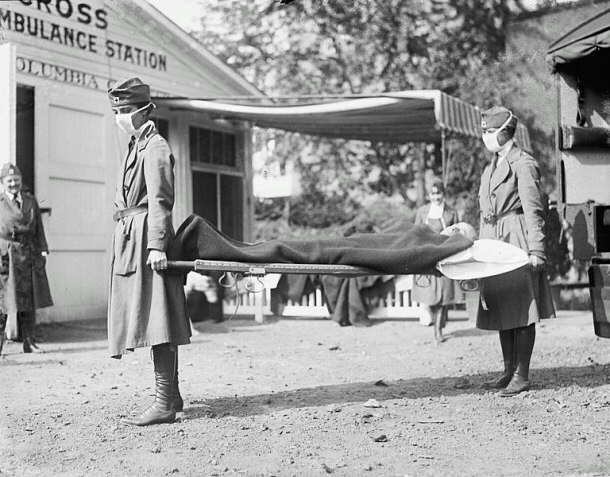
The cause of the epidemic was the H1N1 influenza virus, commonly referred to
as the swine flu. The virus infects the body's immune system, triggering a
cytokine storm. This is a highly lethal immune reaction, where immune cells
react to elevated levels of cytokines (molecules that signal immune cells into
action), which in turn cause more cytokines to be manufactured, creating a
feedback loop that leads to a disproportionately powerful immune reaction. For
this reason, the H1N1 influenza virus had a particularly high mortality rate
among young, healthy adults whose immune systems were particularly strong.
Spanish Flu Victims Burial Site - North River, Labrador,
Canada, 1918

The
body simply could not handle such a strong immune reaction. People with weakened
immune systems, such as children and the elderly, were spared in a fit of
supreme irony.
7) 19th Century Cholera Pandemics
One of the deadliest series of pandemics in history occurred in the 19th
century. Over the course of five pandemics, the once little known disease unique
to the Indian subcontinent claimed an estimated 15 million lives over the course
of the 19th century alone. Outbreaks were often accompanied by a breakdown of
social order and civil unrest, which caused further deaths. The most ironic fact
about cholera is that the disease itself can be easily controlled through proper
sanitation and disinfection, as the primary disease vector is water contaminated
with feces.
Transmission Electron Microscope Image of Vibrio Cholerae -
The Bacteria Responsible for Cholera
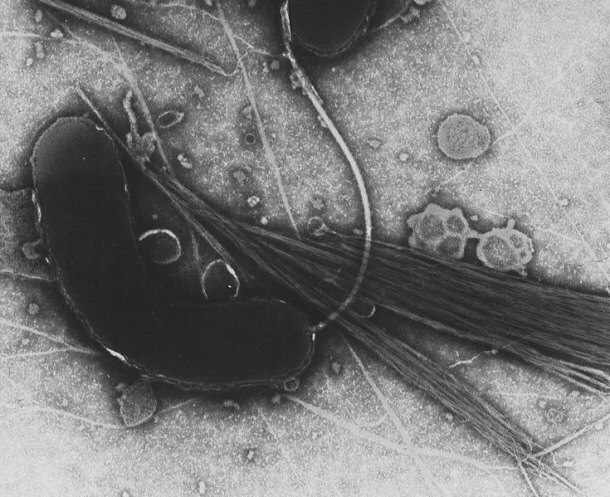
Cholera spreads through the Vibrio cholerae bacterium, which attacks the
small intestine. Symptoms develop very rapidly and may appear within 12 hours of
the initial infection. These include painless diarrhea and vomiting clear
fluid. These symptoms do not stop or worsen, they simply continue until the body
no longer has liquid to expel. If left untreated, a person suffering from
cholera may produce up to 20 liters of diarrhea a day, leading to fatal
dehydration very quick. Treatment is usually a combination of antibiotics
designed to kill off the bacteria and intense hydration to replace lost water
and balance the electrolytes. Cholera still remains a present threat throughout
the world, especially since the bacteria evolves and the risk of
antibiotic-resistant strains emerging is high.
6) Tuberculosis Pandemic
Although many virulent disease have been eradicated thanks to modern
medicine, some remain hard to destroy. Tuberculosis is one of these diseases.
Caused by the Mycobacterium tuberculosis bacterium, it is estimated to be
responsible for over 100 million deaths over the course of the 20th century
alone. About one third of the world's population is estimated to carry the
bacterium, with over 8 million cases reported each year. Out of these,
statistically 2 million perish due to the disease.
Mycobacterium Tuberculosis

Tuberculosis is one of the most infectious diseases, typically attacking the
lungs. Transmitted through the air through coughing, sneezing, and other forms
of projecting fluids from the respiratory systems, new infections are estimated
to occur at a rate of one every second. Although most infections are latent,
those that develop into active infections are characterized by chronic cough
with blood in the spit, fevers, night sweating, and weight loss. Properly
treated, the disease can be controlled and a full recovery can be made. However,
in developing regions of the world without access to proper medical care it
remains a serious problem, especially in densely crowded cities.
5) Obesity Pandemic
 While common sense dictates that pandemics is a term reserved only for
contagious diseases, this is not so. Obesity has become one of the prevalent
problems of the modern world and research into its epidemiology is an ongoing
concern, as are efforts to discover means to counter the growing trends. An
estimated 1.5 billion adults worldwide are overweight, with one third of this
group, 500 million, classified as obese. Practically no region in the world is
free from this health problem, with the only exception being sub-Saharan Africa. While common sense dictates that pandemics is a term reserved only for
contagious diseases, this is not so. Obesity has become one of the prevalent
problems of the modern world and research into its epidemiology is an ongoing
concern, as are efforts to discover means to counter the growing trends. An
estimated 1.5 billion adults worldwide are overweight, with one third of this
group, 500 million, classified as obese. Practically no region in the world is
free from this health problem, with the only exception being sub-Saharan Africa.
Obesity is defined as an accumulation of fat on the body to the point when it
becomes a burden. The amassed fat causes a number of very real, possibly very
serious health conditions, including an increased risk of heart disease,
diabetes, cancer, osteoarthritis, and more. Obviously, the increased risk of
physical injury is also a concern, as the body is unable to properly protect it
against physical trauma when obese.
Obesity in America

The biggest problem with handling this
pandemic is that there is no easy, universal cure available. The best cure
entails physical activity, a healthy lifestyle, and a balanced diet: features
that are increasingly hard to implement in a world increasingly favoring a
sedentary lifestyle and consumption.
4) Malaria Pandemic
One of the most stubborn diseases, malaria has been a clear and present
danger to humans since the ancient times. Although currently it is limited to
tropical and subtropical regions of the planet, it was once also common in
Europe and North America. The disease was known as the Roman Fever in the Roman
Empire, where it was a constant threat to the health of the inhabitants of
imperial territories, including the City itself. In order to grasp the scope of
malaria today, suffice to say that each year there are between 300 and 500
million cases of malaria reported worldwide, with 1.2 million deaths in 2010
alone.
Malaria Disease Spread Map
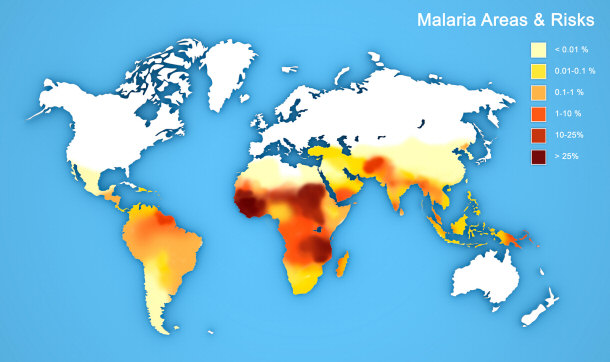
The disease itself is an infection caused by protists belonging to the genus
Plasmodium, which is transmitted through mosquito bites. Malaria symptoms are
similar to flu and include fever, joint pain, vomiting, retinal damage,
convulsions, and neurological symptoms. If left untreated, malaria can create
severe complications that may include acute respiratory distress syndrome, which
is highly lethal. Also encephalopathy may occur along with brain dysfunctions. Although malaria has
accompanied humans since time immemorial, there is no vaccination. The only way
to prevent infection is to prevent mosquito bites in areas threatened with
malaria and to cure symptoms as soon as they appear.
3) Measles Pandemic
One of the most widespread diseases that continues to claim victims even in
this day and age is measles. Although it is strictly controlled by rigorous
vaccination and herd immunity in the developed world, it remains a problem in
the developing and undeveloped countries, where it still claims victims.
Historically, it was one of the most contagious and deadly diseases, especially
in the Americas. In the 16th century, measles infections effectively destroyed
the Inca civilization and depopulated large areas of Central and South America,
including Cuba. The latter is a particularly nasty example, as its population
managed to survive small pox epidemics, only for over two thirds to perish due
to measles. The estimated death toll in the last 150 years alone is over 200
million deaths.
Measles Vaccination Rates Worldwide
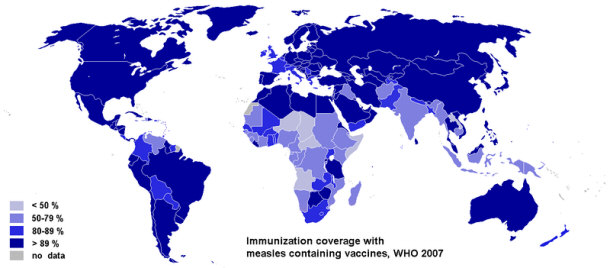
By PhilippN [GFDL, CC-BY-SA-3.0 or CC-BY-SA-2.5-2.0-1.0],
via Wikimedia Commons
Measles itself is a viral infection caused by a Morbillivirus. It's highly
contagious and can be contracted through contact with respiratory system fluids.
In other words, if someone infected with measles or simply carrying the virus
coughs on you, in 9 out of 10 times you'll also either contract the disease or
become a carrier.
Morbillivirus Measles Infection
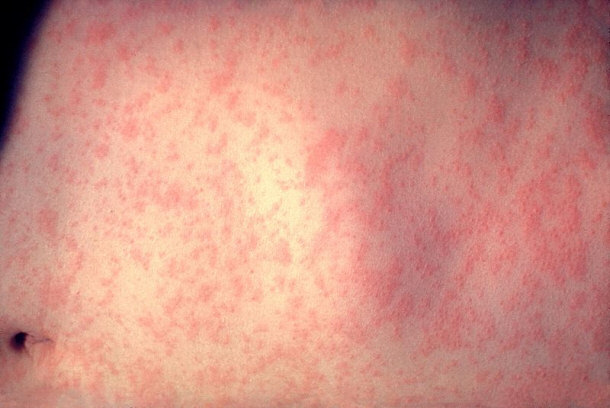
While in the modern world the disease has a very high survival
rate thanks to access to modern medicine, it is also an illness that often
results in complications, ranging from diarrhea all the way to encephalitis.
2) Smallpox Pandemic
It is not hard to choose one of the worst pandemics in history. Smallpox, a
highly infectious disease caused by the Variola virus, was one of the biggest
killers in history. The exact origin of the disease is unknown, as it has
emerged around 10,000 BCE and remained unique to human populations. Smallpox
followed humans whenever they went and has been one of the principal factors in
a number of plagues, including the devastating depopulation of the Americas in
the wake of European colonization.
Smallpox Virus or Variola Virus

In the 20th century alone, smallpox has
claimed an estimate 300 to 500 million lives. Smallpox infections cause symptoms
similar to other viral infections, such as influenza or the common cold: fever,
muscle pain, headache, and general malaise. Within two weeks, however, smallpox
attacks the skin cells, creating the characteristic pimples that are one of the
most recognizable features of the disease. These then develop into papules and
scabs that can go as far as detach the skin from the underlying flesh or lead to
uncontrollable bleeding. Historically, the fatality rate was about 30% for
smallpox infections.
Patient With Advanced Smallpox Infection

Smallpox also has the honor of being one of the few contagious diseases to
have been completely eradicated by a rigorous program of vaccinations worldwide
lasting from 1950 to 1980, overseen by the World Health Organization.
1) Black Death
One of the deadliest and certainly overall the most devastating pandemic in
human history is definitely the Black Death. Killing an estimated 75 to 200
million people in the 14th century, it depopulated the European continent,
killing off between 30 and 60% of the population. It was the largest disaster in
the history of the continent, exacerbated by the population crisis: an
overpopulated Europe suffered from significant food shortages, leading to
malnutrition, which in turn increased susceptibility to disease. This created a
vicious, self-perpetuating cycle that greatly increased the lethality rate. The
impact of the pandemic affected the European civilization deeply and triggered
deep changes in society. For this reason it can be classified as the worst
pandemic in history.
Illustration of Bubonic Plague - 1411

The exact disease that was the cause of the Black Death is a source of
debate. The most commonly accepted theory is that like the Plague of Justinian,
it was caused by Yersinia pestis, which triggered three distinct plagues in
humans during the Black Death: pneumonic, septicemic, and bubonic. All of these
infections are essentially the same, differing only in the body system that is
targeted. Pneumonic plague attacks the lungs, septicemic the blood, and the most
common variant, the bubonic plague, attacks the lymphatic node. This variant
also has the dubious honor of being the source for the plague's name. As
gangrene manifests as black rot that attacks the extremities, victims of the
plague had characteristically blackened, decaying parts of their body. Due to
their blackened appearance and rotting bodies, the name Black Death was coined
because once someone started to turn black, they were going to die very soon.
Conclusion
 Disease accompanied human civilization through the ages, resulting in
countless victims. In fact, it is by far the most widespread cause of death in
history, dwarfing the death tolls caused by human conflicts. By far the worst
aspect of pestilence is that it cannot be brought under control, except for a
few rare cases, like smallpox. Major strides in medicine and improvements in
quality of life during the 20th century limited the chances of a global
pandemic, that is true, but the risk always exists. Like the smallpox and
measles pandemics that devastated the Americas when European colonization
efforts began, there is always the risk that a new, virulent strain of disease
will appear that will ravage the world like in days past. In the end, it all
boils down to personal responsibility: don't forget to vaccinate yourself and
your family, keep a healthy lifestyle, and always maintain a hygienic approach
to pretty much everything. Disease accompanied human civilization through the ages, resulting in
countless victims. In fact, it is by far the most widespread cause of death in
history, dwarfing the death tolls caused by human conflicts. By far the worst
aspect of pestilence is that it cannot be brought under control, except for a
few rare cases, like smallpox. Major strides in medicine and improvements in
quality of life during the 20th century limited the chances of a global
pandemic, that is true, but the risk always exists. Like the smallpox and
measles pandemics that devastated the Americas when European colonization
efforts began, there is always the risk that a new, virulent strain of disease
will appear that will ravage the world like in days past. In the end, it all
boils down to personal responsibility: don't forget to vaccinate yourself and
your family, keep a healthy lifestyle, and always maintain a hygienic approach
to pretty much everything.
History
Top Lists:
15 Biggest Architectural Blunders
Top 15 Most Horrifying Terrorist Attacks
15 Fascinating Facts About the Vietnam War
Top 15 Amazing Ancient Egyptian Architecture
20 Little Known Facts About the Titanic
Top 10 Most Creepiest Abandoned Places in the World
26 Interesting Facts About Henry Ford
List of 15 Tough Ancient Warriors Through History
List of 15 Notorious Roman Emperors and Empresses
Top 15 Worst Pandemics in History
15 Things That Remained the Same in the Past 100 Years
Top 15 Things China Invented First
Top 15 Greatest Inventors in History
15 Interesting Facts About Abraham Lincoln
10 Inventors Who Stole Their Ideas
15 Stories of Hilarious Medieval Victories
15 Detectives Credited With Solving The Biggest Cases In History
15 Fascinating Facts About the Ancient Pyramids
15 Inventions That Were the Result of a Mistake
15 Famous Stories of Execution
16 Rare Facts About the U.S. Presidency
15 Astonishing Leadership Stories that Ended up Successfully
Informational:
Analysis of the Linear B tablets and Wall Paintings
Aristophanes and Classical Greek Comedy
The First War of Scottish Independence
|